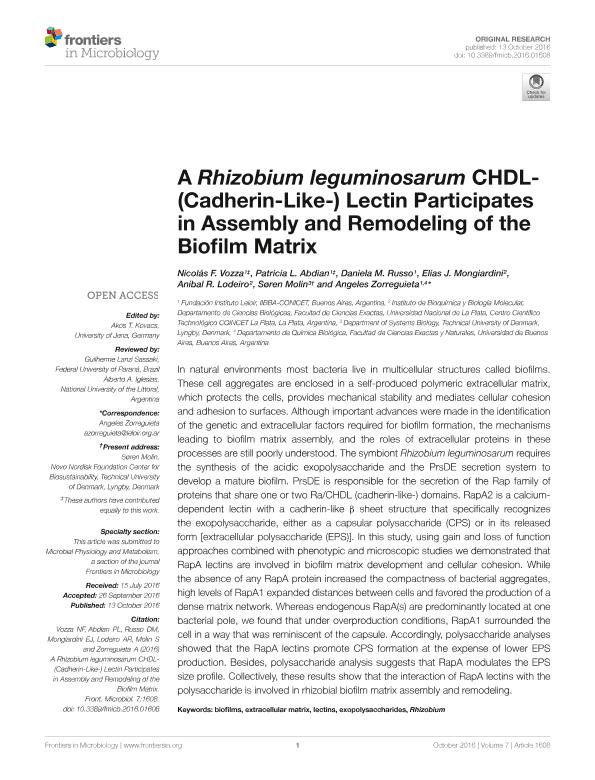Mostrar el registro sencillo del ítem
dc.contributor.author
Vozza, Nicolas Federico

dc.contributor.author
Abdian, Patricia Lorena

dc.contributor.author
Russo, Daniela Marta

dc.contributor.author
Mongiardini, Elias Javier

dc.contributor.author
Lodeiro, Anibal

dc.contributor.author
Molin, Soren
dc.contributor.author
Zorreguieta, Ángeles

dc.date.available
2017-09-26T15:10:43Z
dc.date.issued
2016-10
dc.identifier.citation
Vozza, Nicolas Federico; Abdian, Patricia Lorena; Russo, Daniela Marta; Mongiardini, Elias Javier; Lodeiro, Anibal; et al.; A Rhizobium leguminosarum CHDL- (Cadherin-Like-) Lectin Participates in Assembly and Remodeling of the Biofilm Matrix; Frontiers; Frontiers in Microbiology; 7; 10-2016; 1608
dc.identifier.uri
http://hdl.handle.net/11336/25100
dc.description.abstract
In natural environments most bacteria live in multicellular structures called biofilms. These cell aggregates are enclosed in a self-produced polymeric extracellular matrix, which protects the cells, provides mechanical stability and mediates cellular cohesion and adhesion to surfaces. Although important advances were made in the identification of the genetic and extracellular factors required for biofilm formation, the mechanisms leading to biofilm matrix assembly, and the roles of extracellular proteins in these processes are still poorly understood. The symbiont Rhizobium leguminosarum requires the synthesis of the acidic exopolysaccharide and the PrsDE secretion system to develop a mature biofilm. PrsDE is responsible for the secretion of the Rap family of proteins that share one or two Ra/CHDL (cadherin-like-) domains. RapA2 is a calcium-dependent lectin with a cadherin-like β sheet structure that specifically recognizes the exopolysaccharide, either as a capsular polysaccharide (CPS) or in its released form [extracellular polysaccharide (EPS)]. In this study, using gain and loss of function approaches combined with phenotypic and microscopic studies we demonstrated that RapA lectins are involved in biofilm matrix development and cellular cohesion. While the absence of any RapA protein increased the compactness of bacterial aggregates, high levels of RapA1 expanded distances between cells and favored the production of a dense matrix network. Whereas endogenous RapA(s) are predominantly located at one bacterial pole, we found that under overproduction conditions, RapA1 surrounded the cell in a way that was reminiscent of the capsule. Accordingly, polysaccharide analyses showed that the RapA lectins promote CPS formation at the expense of lower EPS production. Besides, polysaccharide analysis suggests that RapA modulates the EPS size profile. Collectively, these results show that the interaction of RapA lectins with the polysaccharide is involved in rhizobial biofilm matrix assembly and remodeling.
dc.format
application/pdf
dc.language.iso
eng
dc.publisher
Frontiers

dc.rights
info:eu-repo/semantics/openAccess
dc.rights.uri
https://creativecommons.org/licenses/by-nc-sa/2.5/ar/
dc.subject
Biofilms
dc.subject
Extracellular Matrix
dc.subject
Rhizobium
dc.subject
Lectins
dc.subject.classification
Bioquímica y Biología Molecular

dc.subject.classification
Ciencias Biológicas

dc.subject.classification
CIENCIAS NATURALES Y EXACTAS

dc.title
A Rhizobium leguminosarum CHDL- (Cadherin-Like-) Lectin Participates in Assembly and Remodeling of the Biofilm Matrix
dc.type
info:eu-repo/semantics/article
dc.type
info:ar-repo/semantics/artículo
dc.type
info:eu-repo/semantics/publishedVersion
dc.date.updated
2017-09-08T20:11:27Z
dc.identifier.eissn
1664-302X
dc.journal.volume
7
dc.journal.pagination
1608
dc.journal.pais
Suiza

dc.journal.ciudad
Lausanne
dc.description.fil
Fil: Vozza, Nicolas Federico. Consejo Nacional de Investigaciones Científicas y Técnicas. Oficina de Coordinación Administrativa Parque Centenario. Instituto de Investigaciones Bioquímicas de Buenos Aires. Fundación Instituto Leloir. Instituto de Investigaciones Bioquímicas de Buenos Aires; Argentina
dc.description.fil
Fil: Abdian, Patricia Lorena. Consejo Nacional de Investigaciones Científicas y Técnicas. Oficina de Coordinación Administrativa Parque Centenario. Instituto de Investigaciones Bioquímicas de Buenos Aires. Fundación Instituto Leloir. Instituto de Investigaciones Bioquímicas de Buenos Aires; Argentina
dc.description.fil
Fil: Russo, Daniela Marta. Consejo Nacional de Investigaciones Científicas y Técnicas. Oficina de Coordinación Administrativa Parque Centenario. Instituto de Investigaciones Bioquímicas de Buenos Aires. Fundación Instituto Leloir. Instituto de Investigaciones Bioquímicas de Buenos Aires; Argentina
dc.description.fil
Fil: Mongiardini, Elias Javier. Consejo Nacional de Investigaciones Científicas y Técnicas. Centro Científico Tecnológico Conicet - La Plata. Instituto de Biotecnología y Biología Molecular. Universidad Nacional de La Plata. Facultad de Ciencias Exactas. Instituto de Biotecnología y Biología Molecular; Argentina
dc.description.fil
Fil: Lodeiro, Anibal. Consejo Nacional de Investigaciones Científicas y Técnicas. Centro Científico Tecnológico Conicet - La Plata. Instituto de Biotecnología y Biología Molecular. Universidad Nacional de La Plata. Facultad de Ciencias Exactas. Instituto de Biotecnología y Biología Molecular; Argentina
dc.description.fil
Fil: Molin, Soren. Technical University of Denmark; Dinamarca
dc.description.fil
Fil: Zorreguieta, Ángeles. Consejo Nacional de Investigaciones Científicas y Técnicas. Oficina de Coordinación Administrativa Parque Centenario. Instituto de Investigaciones Bioquímicas de Buenos Aires. Fundación Instituto Leloir. Instituto de Investigaciones Bioquímicas de Buenos Aires; Argentina
dc.journal.title
Frontiers in Microbiology
dc.relation.alternativeid
info:eu-repo/semantics/altIdentifier/url/http://journal.frontiersin.org/article/10.3389/fmicb.2016.01608/full
dc.relation.alternativeid
info:eu-repo/semantics/altIdentifier/doi/http://dx.doi.org/10.3389/fmicb.2016.01608
Archivos asociados
